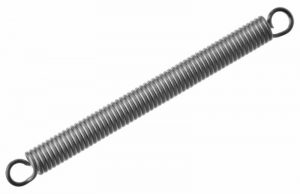
Consisting of a coiled piece of metal, springs are used in many industrial and consumer applications. They are designed to stretch while storing mechanical energy. When a spring is stretched, it will uncoil. Even when just partially uncoiled, a spring will store this mechanical energy. There are many different types of springs, however, two of the most common being compression and extension. While they both store mechanical energy, they differ in several ways.
What Is an Extension Spring?
Also known as a tension spring, an extension spring is intended to operate under a load that creates tension. As shown in the adjacent image, they typically feature a hook or loop on each end. To use an extension spring, you must attach the ends to two components. If the components try to pull apart from each other, the extension spring will force them back together.
Extension springs receive their namesake from their ability to extend. When connected to two components that try and pull away from each other, an extension spring will become longer. Extension springs are available in different sizes and materials, but they are all designed to extend under a load. This extension creates tension that forces the two connected objects back together.
What Is a Compression Spring?
A compression spring is a type of spring that compresses under a load. Like extension springs, they consist of a coiled piece of metal. If you compare an extension spring to a compression spring, though, you’ll notice that the latter type has a wider and broader coil than its counterpart. Extension springs consist of a narrow piece of coiled metal, whereas extension coils consist of a broader piece of coiled metal.
Compression springs differ from extension springs in regards to how they work. While extension springs become longer under a load, compression springs become shorter.
Compression springs are designed for use in applications where two components try to push towards each other. To prevent the components from making contact, a compression spring may be used. The compression spring is placed between the two components where it compresses. As the two components try to push towards each other, the compression spring will compress. In turn, it will store mechanical energy that subsequently pushes the components back out.
Extension springs and compression springs aren’t the same. Extension springs are intended for use when two components try and pull away from each other. In comparison, compression springs are intended for use when two components try and push towards each other.
